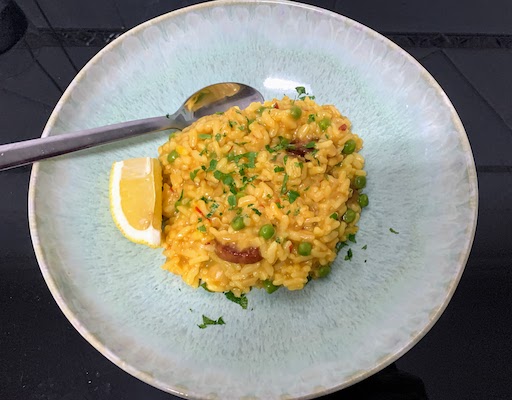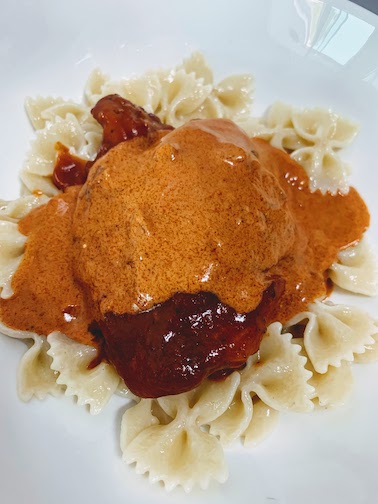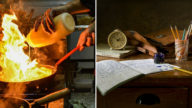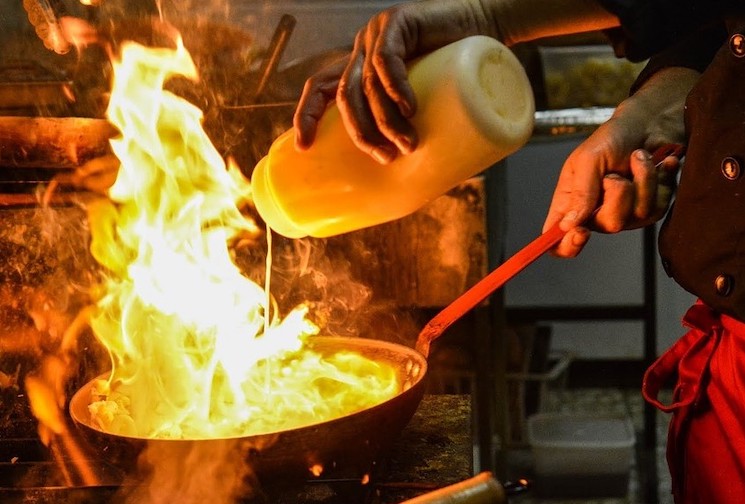Introduction
I have always liked to cook. It has always astounded me that people would rather order food in or go out to eat when, for a fraction of the cost, you can make something just as absolutely horrible right in your own kitchen.
People sometimes confuse me for a chef. When someone tells me this, my insides start to giggle. Nothing could be further from the truth.
I am a cook.
I follow recipes and their directions. I only deviate from the ingredients when my pantry, refrigerator, or current country doesn’t have a specific item. My ability to create something from scratch is like my ability to draw – it’s just not going to happen. I was always a paint-by-numbers girl.
Where I go for inspiration and laughs
My favorite site for recipe collection is the New York Times Cooking. It comes with my Times digital subscription and stores my favorite recipes.
My guilty pleasure on this site is to read the comments posted about each recipe. Even the simplest recipes generate heated discussions. First of all, most people that comment have NOT made the recipe, and if they have they substituted eight of the ten ingredients and then wondered why it did not turn out well.
Recipes that have an ethnic origin have “experts” from that region explaining how the recipe is just not authentic. “My Portuguese grandmother would NEVER do it that way,” or “My Italian grandfather would roll over in his grave if he knew you used that pasta”.
My absolute favorite is when they publish a recipe for a really full fat dish like Fettuccini Alfredo and people actually get the vapors over the fat in the dish. I want to scream, “Why did you open it, it’s fettuccini alfredo, for God’s sake”?
Two new recipes
Today, I want to share with you two of my new favorite easy recipes. I picked these so that I could learn to use two of the ingredients that we picked up in Spain – saffron and pimentón (paprika) – both picante (hot) and dulce (sweet). Both recipes would be perfect for a family meal or an impromptu dinner party with friends. Each one breaks with “traditional” recipes, but boy are they good!
Oven Baked Risotto with Saffron and Chorizo
My first share is Oven Baked Risotto with Saffron and Chorizo. Your eyes are not deceiving you. I said “oven baked risotto”. Even in Portugal I am hearing the collective cries of all 60,260,940 living Italians, not to mention those in their graves.
The recipe comes from Kate, a fellow blogger at My Little Larder. She is a busy mom and had no time to stand over a hot stove stirring and stirring and stirring. The results were creamy, silky, and smooth, and the risotto still had a bit of a bite. She used Spanish chorizo. I used Portuguese chorijo. You use what you can find.

Cut the recipe in half if you can’t eat it all at once. There is nothing sadder than leftover, soggy, lifeless risotto. (Though Mike will tell you that the leftovers were still good the next day.)

Oven Baked Risotto with Saffron and Chorizo
Equipment
- 1 Cast Iron Enamel Pan with Lid
Ingredients
- 1 cup frozen Peas, thawed
- 1 tsp olive oil, cold pressed
- 7 oz Portuguese or Spanish Chorizo or 200 g
- 1 medium leak, white part only
- 2 cloves garlic, crushed
- 1 generous pinch saffron threads
- 1 tsp chilli flakes, optional
- 1.5 cups carnaroli or arborio rice
- 1/2 cup dry white wine
- 5 cups chicken stock
- 0.8 oz. butter or 20 g
- 1.8 oz. Parmigiana Reggiano or 50 g
- 4 wedges lemon
Instructions
- Preheat oven to 400F/200C set on convection if you have it
- Remove peas from freezer and set aside in a bowl at room temperature.
- Thinly slice chorizo into 1/2cm/1/4in slices. Set aside. Slice the white part of the leek (discard the green part or use it for stock) in half lengthways. Finely slice each section. Fill a small bowl with water, put cut leaks in water to wash. The leaks will float and the grit will fall to the bottom of the bowl. Remove leaks and set aside.
- Drizzle olive oil in an oven-proof saucepan or Dutch Oven (I like to use my cast-iron enamel Le Creuset pot for this) over medium-high heat. Add chorizo and cook for about 5 minutes until browning and starting to crisp. Remove with a slotted spoon and set aside on a plate lined with absorbent paper towels.
- Reduce the heat to medium, add sliced leek and cook until soft, about 5 min. Remove the pot from the heat and add garlic, saffron, chilli (optional), rice, wine, and 4 cups of stock. Cover and place in the oven for 15 min. Remove, stir, cover again and return to the oven for a further 10 min. Remove again, stir through the peas and cover. Return to the oven for another 5 min or until the rice is tender and the liquid is absorbed.
- When the risotto is cooked, remove from oven and stir through remaining 1 cup of chicken stock, 20g/0.7oz of butter and grated parmesan cheese and stir vigorously until creamy. Gently stir through the chorizo, or scatter on top. The residual heat of the risotto will heat the chorizo or if you like you can put it in an oven proof dish and place it in the oven for 5 min when you add the peas to the risotto. Serve immediately with extra grated parmesan cheese.
- Serve with a slice of lemon.
Chicken Paprikash
My second share is Sam Sifton’s Chicken Paprikash, found at New York Times Cooking. This dish originated in Hungary. The comments were all over the place, but one thing they had in common was a five star rating for a delicious dish. The main takeaways were to remove the pan from the heat when adding the paprika so that it doesn’t burn, and to always use fresh paprika. Mr. Sifton commented, “[s]pices lose their flavor over time but few as quickly as paprika, which starts out tasting of pepper and sunshine but deteriorates in but a few months to sawdust and bitterness.”

He used Hungarian paprika, and I used Spanish. You use what you can find.

Chicken Paprikash
Equipment
- Dutch Oven
Ingredients
- 3-4 lbs. pounds chicken thighs and drumsticks, or whole chicken legs
- Kosher salt and freshly ground black pepper to taste
- 1 tbsp neutral oil, like canola
- 3 tbsp unsalted butter
- 1 large yellow or Spanish onion, peeled and diced
- 3 cloves garlic, peeled and minced
- 3 tbsp Hungarian paprika, sweet or hot, or a combination
- 3 tbsp all-purpose flour
- 1 cup canned crushed tomatoes or 1 large ripe tomato, chopped
- 1 cup chicken broth, homemade or, if not, low-sodium
- 1 lb egg noodles
- 3/4 cup sour cream
Instructions
- Heat oven to 400. Season the chicken aggressively with salt and pepper. Heat the oil and 1 tablespoon of the butter in a large, heavy, oven-safe sauté pan or Dutch oven set over high flame, until the butter is foaming. Sear the chicken in batches, skin-side down, until it is golden and crisp, approximately 5 to 7 minutes. Then turn the chicken over, and repeat on the other side, approximately 5 to 7 minutes. Remove chicken to a plate to rest.
- Pour off all but 3 tablespoons of the accumulated fat in the pot. Return the pot to the stove, over medium heat, and add the onion. Cook, stirring frequently with a spoon to scrape off any browned bits of chicken skin, until the onion has softened and gone translucent, approximately 5 minutes. Add the garlic, and stir again, cooking it until it has softened, approximately 3 to 4 minutes. Add the paprika and the flour, and stir well to combine, then cook until the mixture is fragrant and the taste of the flour has been cooked out, approximately 4 to 5 minutes.
- Add tomatoes and broth, whisk until smooth and then nestle the chicken back in the pan, skin-side up. Slide the pan or pot into the oven, and cook until the chicken has cooked through and the sauce has thickened slightly, approximately 25 to 30 minutes.
- Meanwhile, set a large pot of heavily salted water to boil over high heat. Cook noodles in the water until they are almost completely tender, approximately 7 to 8 minutes. Drain the noodles, and toss them in a bowl with the remaining butter, then toss again to coat.
- Place the chicken on top of the noodles, then add the sour cream to the sauce, stir to combine and ladle it over the whole.
Notes
Conclusion
I enjoyed making these two new dishes, almost as much as Mike enjoyed eating them! Give them a try and let me know what you think.
Do you have a favorite recipe that uses saffron or pimentón? Share your secret in the comments below or with a note via the Contact Us form.
Until next week / Até a próxima semana
Mary
The Cook



Sounds so yummy, Mary! I love what you said too about the NY Times Cooking recipes. I also am a subscriber but save the recipes and rarely get to them. I’ll start reading the comments as they sound entertaining! Glad you are enjoying Portugal and were able to get home to see your new grandson.
Thanks Kelly. It is so good to hear from you. Yeah, the comments on the recipes are worth the read. Many times they offer a real solution that you can add as a “private note” that you can see when you make the recipe. I hope all is well with you and your family. We miss you.
It all looks so delicious and wonderful. So glad you are enjoying and discovering new places and foods on your travels! I loved Madrid and the Food. Love and hugs…Eddie and Sue
I am always amazed at all the places you got to go. We love Madrid as well. We miss you both and hope this finds you happy and well.
Yum! I associate both spices w Sweden. In our home in Cali, we all knew Christmas was around the corner when it was time to make the “saffransbröd”- I’d watch fascinated as my mom dropped strands of saffron in a little vodka to bring out their flavor, I was in awe watching her plait the dough. Once I had grown up enough, the flavor, with a good cup of coffee to go with it….heaven! In 2013, my brothers and I spent time with my dad in a lovely cottage in the Stockholm archipelago and took turns cooking. Hans and Annemarie took a turn and prepared this absolutely succulent chicken stew. It had a flavor totally new to me. Turns out, they’d seasoned the stew with smoked, sweet “Pimentón de la vera.” I fell in love….All this to say i am tickled by this post and will for sure try both of them.
Oh, and by the way, you may not be ‘chef’ but damn, you’re a good cook!
Rosa,
I love to hear about you and your family. What a rich and wonderful life you have led. I am amazed that I have lived this long and have never experienced the lovely world of Paprika. I have used a teaspoon here or there but never have I had a dish that combined both the sweet and the hot. I’ll be on the lookout for more ways to consume it.
I will be trying the first recipe, sans chorizo. My grandmother was Hungarian and I recall this dish fondly. D and I used to argue over Hungarian vs Czech….glad to read I was right!
Let us know how it turns out!
Both recipes look delicious, Mary and I’m looking forward to trying them myself. I love the fact that I can print them out, too.
Thanks for writing and sharing this delicious post! -CW
Thanks Carol. The print function is something I have wanted for a while. Thanks to Mike for the add-on!